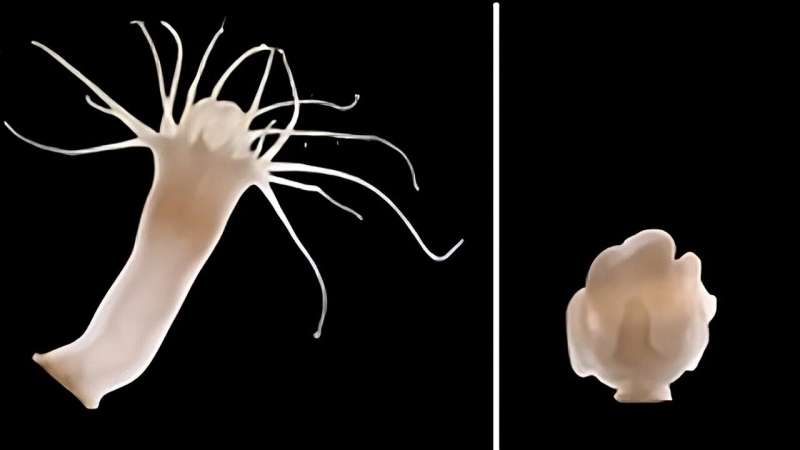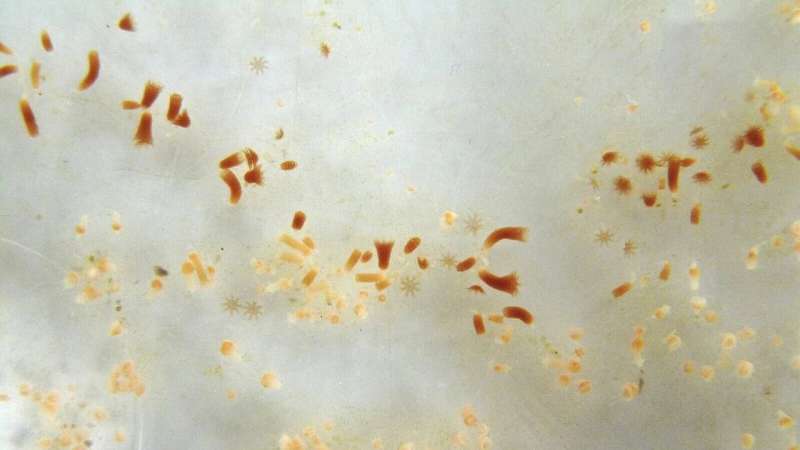This article has been reviewed according to Science X's editorial process and policies. Editors have highlighted the following attributes while ensuring the content's credibility:
fact-checked
peer-reviewed publication
trusted source
proofread
How polyps of the moon jellyfish repel viral attacks on their microbiome

Bacteriophages, or phages for short, are viruses that infect bacteria and kill them through a lysis process. Phages can kill bacteria on or in a multicellular host organism, such as the polyp of the moon jellyfish. Phages specialize in specific bacteria and can significantly alter the bacterial composition of a polyp's microbiome.
The effect of phages on the microbiome and, thus, the fitness of polyps is still largely unexplored. Microbiologists at Kiel University, led by Professor Ruth Schmitz-Streit, have shown for the first time in laboratory experiments that polyps regenerate quickly after infection with bacteriophages.
The findings suggest that the resistance of the moon jellyfish's natural microbiome to phages from the Baltic Sea is very pronounced and contribute to our knowledge of the effect of these often overlooked, tiny key players on the microbiome and, ultimately, the fitness of the moon jellyfish. The results have recently been published in the journal Frontiers in Microbiology.
Polyps show high resistance after virus attack
In the polyp stage, the animals are attached to the seabed and use their tentacles to catch food from the water. On the surface of their stalked body are numerous bacteria that form the so-called microbiome, which plays an important role in the fitness of the polyp.
In previous studies, microbiologists at the Institute of General Microbiology have already shown how important the natural microbiome is for the vegetative reproduction of the moon jellyfish and its defense against pathogens.
Their current study has investigated how the microbiome survives an infection with bacteriophages and what the consequences are for the polyps. In laboratory experiments, the researchers observed that introducing the phages led to a significant change in the body shape of the polyps, but only temporarily. After the virus defense, the polyps returned to their normal shape.
"After the polyps were treated with specific bacteriophages, their bodies became severely shortened and rounded and they lost their tentacles. These are usually signs of polyp death. However, we did not see a single dead polyp; on the contrary, all the polyps regenerated completely. This high resilience surprised us," says Melissa Stante, Ph.D. student in Ruth Schmitz-Streit's research group and first author of the study.

Test series on treated polyps shows rapid recovery of microbiome
One explanation for this could be that the polyps, or more precisely their microbiome, quickly adapt to the presence of the phages and are therefore able to prevent permanent damage. The scientists sampled the microbiome of the polyps over a period of five days. They found that the most common type of bacteria, Mycoplasma, decreased initially, but recovered after 24 hours.
"In the polyps of moon jellyfish from the Baltic Sea, the microbiome is mainly dominated by a specific bacterium, an uncultivated Mycoplasma bacterium. This colonizer was significantly reduced when phages were administered. This allowed other bacteria to temporarily gain dominance.
"The exact factors that favor the initial reduction, but also the subsequent rapid regeneration of the Mycoplasma, are now the subject of further research," says PD Dr. Nancy Weiland-Bräuer. The dynamics in the microbiome's composition were synchronized with the deformation of the polyps.
Phage-microbiome-host interactions have cascading effects on the ecosystem
Knowledge of the dynamic interaction between the moon jellyfish, its microbiome and phages contributes to understanding marine nutrient and element cycles. At the same time, the process plays an essential role in understanding ecosystem stability and is a building block for research into diseases in the Baltic Sea ecosystem.
In addition, the results will contribute to the "Ocean Health" research initiative, which focuses on the impact of health and disease in the context of climate change and potential future environmental conditions. In addition to lysing bacteria, phages can exchange genetic material with host microorganisms, helping the microbiome adapt to changing environmental conditions.
"The rapid regeneration of the polyp shape after phage treatment seems to correlate with the recovery of the moon jellyfish's natural microbiome. This is a strong indication that the resistance of the moon jellyfish microbiome to phages from the Baltic Sea is very pronounced.
"The factors that make the microbiome so resilient may also provide important clues as to how to protect the healthy microbiome in humans. However, we are still in the relatively early stages of basic research," says Professor Dr. Ruth Schmitz-Streit, head of the research group.
More information: Melissa Stante et al, Marine bacteriophages disturb the associated microbiota of Aurelia aurita with a recoverable effect on host morphology, Frontiers in Microbiology (2024). DOI: 10.3389/fmicb.2024.1356337
Journal information: Frontiers in Microbiology
Provided by Kiel University




















